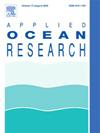Scour near low-crested breakwaters: review and technical challenges
IF 4.3
2区 工程技术
Q1 ENGINEERING, OCEAN
引用次数: 0
Abstract
Low-crested breakwaters are widely used structures for coastal protection, but they are vulnerable to scouring caused by wave and current action. This paper analyses information from available mobile bed physical models, the progress made in recent years on numerical modelling alongside the major limitations of the developed models and the available formulations for scour hole prediction and protection design. Physical modelling has been the primary approach for studying scour processes around low-crested breakwaters. However, existing scour depth prediction formulations have limited applicability to these structures due to their geometric characteristics. Gaps in current research include uncertainties derived from the use of scaling laws for mobile bed physical models, the effects of plunging breakers on the evolution of scour phenomena, and challenges arising from the permeability and crest freeboard of the structure and its effect on the quantification of scour phenomena. Furthermore, there is a need to investigate the impact of the slope angle, water depth, crest freeboard and wave characteristics on the scour hole evolution, as well as to optimise scour protection elements in terms of their geometric characteristics. Moreover, this review emphasises the importance of using integrated methodologies combining physical and numerical modelling with monitoring data, to comprehensively understand scour phenomena and develop mitigation measures.
低波峰防波堤附近的冲刷:审查和技术挑战
低波峰防波堤是目前广泛应用的海岸防护结构,但其易受波浪和水流冲刷的影响。本文分析了现有的移动床物理模型的信息、近年来数值模拟的进展、已开发模型的主要局限性以及冲刷孔预测和防护设计的现有公式。物理模型一直是研究低波峰防波堤冲刷过程的主要方法。然而,由于这些结构的几何特性,现有的冲刷深度预测公式对这些结构的适用性有限。目前研究的空白包括:移动床物理模型使用标度定律所带来的不确定性,下坠式破浪对冲刷现象演变的影响,以及结构的渗透性和干舷峰及其对冲刷现象量化的影响所带来的挑战。此外,还需要研究坡角、水深、波峰干舷和波浪特性对冲刷孔演化的影响,并根据冲刷防护元件的几何特性对其进行优化。此外,该审查强调了使用综合方法将物理和数值模拟与监测数据相结合的重要性,以全面了解冲刷现象并制定缓解措施。
本文章由计算机程序翻译,如有差异,请以英文原文为准。
求助全文
约1分钟内获得全文
求助全文
来源期刊

Applied Ocean Research
地学-工程:大洋
CiteScore
8.70
自引率
7.00%
发文量
316
审稿时长
59 days
期刊介绍:
The aim of Applied Ocean Research is to encourage the submission of papers that advance the state of knowledge in a range of topics relevant to ocean engineering.
 求助内容:
求助内容: 应助结果提醒方式:
应助结果提醒方式:


